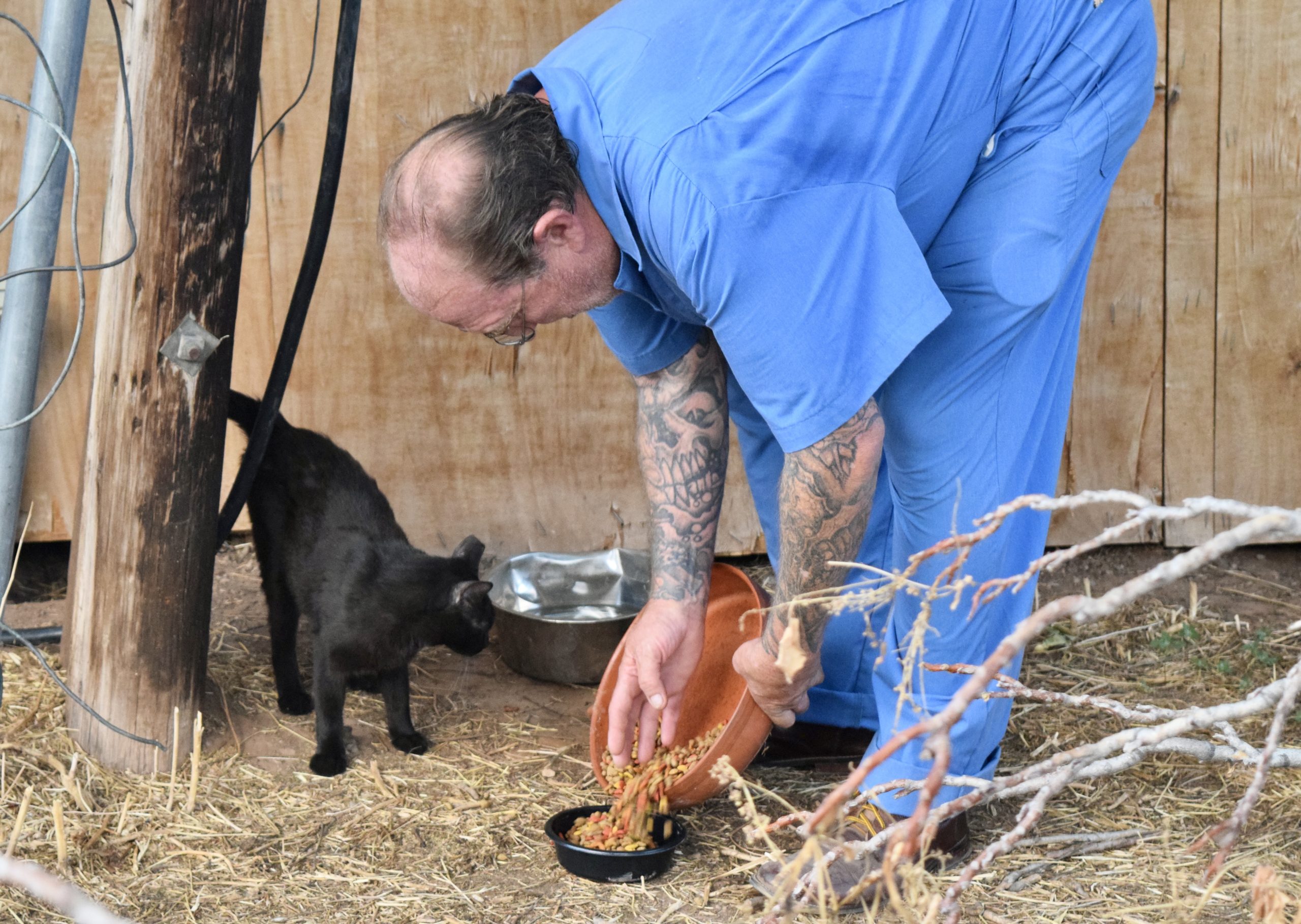Some information may be outdated.
Travis Garica starts each day at 3 a.m. with a pot of coffee. He works out the aches and pains left over from a decades-old severe back injury, and at 5:30 drives across town to feed a community of cats—dozens of stray or feral felines that live in the nooks and crannies of the Walnut Lane mobile home park. He cleans and refreshes their water bowls, opens up feeders that have been racoon-proofed overnight, checks cats’ appearance for any health concerns, and shares some affection.
“I’ve been doing this for two and a half years, and I haven’t missed one day,” Garcia said. Even when he had the flu so bad he was vomiting and feeling faint, he was true to the cats’ three-times-a-day feeding schedule. He’s grateful he hasn’t caught COVID—he worries about who would care for the cats if he were too sick to tend to them.
Garcia’s Walnut Lane project started out when a friend who lived in the trailer park was diagnosed with terminal cancer. She asked him to take care of her four pet cats; while doing that, Garcia noticed how many other cats were in the neighborhood, mostly tame and friendly animals that he assumes were once pets, now abandoned by their owners. Garcia eventually found new homes for his friend’s pets, but he continued coming back to the neighborhood to watch over the other stray cats. The animals recognize when he’s coming and emerge from hidey-holes and from under cars and brush to eat. If Garcia notices one is missing, he rings a small bell to let them know he’s there. Sometimes they still don’t respond; Garcia said he finds and disposes of dead cats with some frequency.
The Humane Society of Moab Valley could not be reached for comment, but according to its website, the organization has maintained a “trap, neuter return,” or TNR, program for stray cats since the early 2000s. Veterinarians “tip” one ear, cutting off the very end, to identify a cat that’s been spayed or neutered. Cats are also vaccinated against rabies and other cat diseases. Usually they’re then returned to their colonies. Studies have shown that if cats are removed from colonies, it creates a “vacuum” effect, and fertile female cats will produce more kittens to fill the vacancy—that’s why fixing cats is important to reduce populations. Volunteers supply wildlife-proof gravity feeders, which reduce cats’ predation on birds and other wildlife. Some of the feeders in the Walnut Lane neighborhood were installed by the Humane Society, and others by Garcia; Garcia maintains his feeders and alerts the HSMV when their feeders are empty.
The HSMV website says they’ve sterilized almost 4,000 cats since the program began, and that the “community” cat population has begun to decline. Many of the cats in Walnut Lane have tipped ears, indicating they’ve been sterilized.

“Currently, volunteers oversee 105 community cats at 10 locations in Grand County. This is down from 187 cats in 16 locations in 2016,” according to the HSMV website. The program costs about $17,000 a year, but HSMV says that’s less expensive and more effective than euthanization—not to mention more humane. The numbers on the website may not reflect the current situation: Garcia says he takes care of about 75 cats just in the Walnut Lane area. Animal rescue advocates remind pet owners to get their pets fixed to prevent the proliferation of homeless animals, and to avoid leaving food outside unattended where it’s likely to attract wildlife. The Humane Society offers free or discounted spay and neuter vouchers for low-income households.
The Humane Society does what it can to manage community cat populations, but the organization has limited capacity, as does Garcia. He’s particularly worried about what will happen to the community cats in the Walnut Lane neighborhood when scheduled construction of new affordable housing begins. He hopes people will consider adopting cats from the colony. Many are friendly and would adapt well to domestic life: many trot up to Garcia to be pet and fed when they see him, including a black male Garcia calls Clyde.
The Humane Society can’t accept stray cats at its shelter unless they’ve been quarantined for 14 days, to prevent the possibility of spreading illness at the shelter. Volunteers who can offer a place to quarantine cats would help with the animals’ adoption prospects. Garcia said he also needs help maintaining the feeding schedule and trapping cats to have them fixed and vaccinated. He can be reached at garciatravis88@gmail.com.
If adoption, volunteering or offering a space to quarantine aren’t options for people, Garcia welcomes donations to support his work—he spends hundreds of dollars on cat food, medicine, and flea treatments each month. There’s a donation account at the Eastern Community Credit Union—the account number is 59572—and donors can get a receipt for a tax write-off.
Garcia has found homes for many cats, and adopted several animals himself—he has seven cats and two dogs. He feels a sense of peace around the animals.
“There’s a lot of hate in the world. They don’t have that,” he said.
Appreciate the coverage? Help keep local news alive.
Chip in to support the Moab Sun News.





